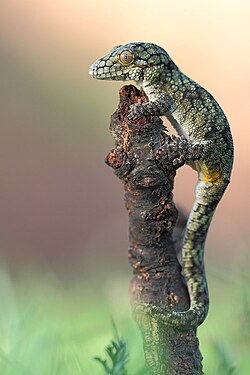| Eurydactylodes vieillardi | |
|---|---|
 | |
| adult male | |
| Scientific classification | |
| Kingdom: | Animalia |
| Phylum: | Chordata |
| Class: | Reptilia |
| Order: | Squamata |
| Suborder: | Gekkota |
| Family: | Diplodactylidae |
| Genus: | Eurydactylodes |
| Species: | E. vieillardi |
| Binomial name | |
| Eurydactylodes vieillardi (Bavay, 1869) | |
| Synonyms [2] | |
Eurydactylodes vieillardi, sometimes known commonly as Bavay's gecko or Vieillard's chameleon gecko, is a species of lizard in the family Diplodactylidae. The species is endemic to Grande Terre in New Caledonia. [2]
